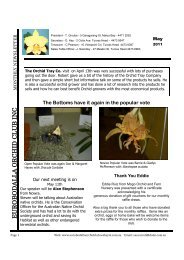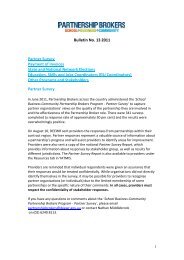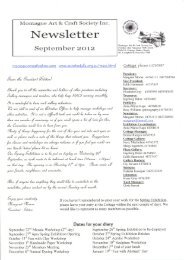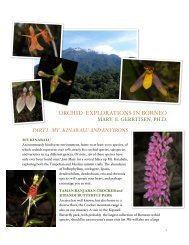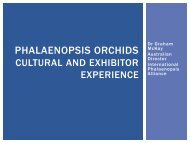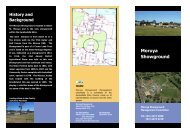Orchid Growing Substrates
Orchid Growing Substrates
Orchid Growing Substrates
Create successful ePaper yourself
Turn your PDF publications into a flip-book with our unique Google optimized e-Paper software.
Standalone products<br />
Apart from Orchiata, there are some ‘popular’ standalone products, rockwool, sphagnum moss and Tree fern.<br />
For the commercial grower or the caring hobbyist it is the best in a way, if the media is suitable by itself.<br />
- Rockwool has been commented earlier. One of the problems too is that, once it has been pretreated<br />
for use, when potting, the pressure applied will change its behavior in the pot. Sometimes too the<br />
rockwool cubes can collapse under the finger’s pressure, not a good sign that they are as ‘stable’ as<br />
claimed.<br />
- Sphagnum moss. It is a strange media in some ways. When very loosely used, as few fibers in the pots,<br />
it dries up very quickly. When packed reasonably, it can retain a lot of water. When packed and<br />
stuffed in the pot until it is borderline concrete hard, or nearly so, as it is the current practice of many<br />
nurseries, it retains much less water. However, tight packing makes it less water retentive, but can<br />
build up decaying bacteria’s, that the roots can take up. People that pack it very tightly usually do not<br />
water as a drench, rather they moisten it regularly. It needs to be repotted, with some marginal<br />
exceptions, quite frequently. In Taiwan, the rule is to repot every 3-4 months at the maximum, very<br />
tightly packed. They use very soft pots, which tend to collapse a bit on the side, which keeps the sides<br />
of the sphagnum potted plant well aerated too. They use heavy feeding schedules too, but only<br />
moistening the sphagnum moss. In that they are very successful. In Japan, some growers use only<br />
New Zealand sphagnum moss to grow their Paphiopedilum, though the plants do not look like so<br />
happy, except with very frequent repottings, and quite hard water, where they still need quite<br />
frequent repotting. The Maudiae types and some of the species behind are well suited to New<br />
Zealand sphagnum moss as a single potting material. On the other side, the Parvisepalum can perform<br />
well in Chinese sphagnum moss, not in New Zealand sphagnum moss, for the reasons explained<br />
before. Chinese moss has a lower buffering capacity and water retention, so its pH can go up in an<br />
easier way. It requires first high quality Chinese sphagnum moss, which is usually harvested by orchid<br />
collectors on special requests with very frequent repottings. But Xavier saw big clumps of all the local<br />
Chinese Paphiopedilum species in it. One more problem, it is suitable for cool to cold growing<br />
climates, as the Chinese sphagnum moss will spoil very quickly if the temperatures are intermediate<br />
to warm. Yet it is worth to mention it.<br />
- Tree fern has been covered previously, as said, it is one of the best potting mixes along with Orchiata,<br />
yet it is not available in reasonable quantities, its export is banned from many countries, and it is not<br />
really ecologically harvested. It is expensive to get good quality, more than to import Orchiata bark in<br />
Vietnam, if one wants the good quality tree fern. It is popular in Malaysia and Indonesia, where some<br />
massive clumps of Paphiopedilum can be seen. Like Orchiata, it is very long lasting and retains its<br />
structure for a very long time. Unlike Orchiata, it is very acidic and needs sometimes heavy pretreatments,<br />
and unlike Orchiata, it really destroys the ecosystems.<br />
Xavier Garreau de Loubresse<br />
38



